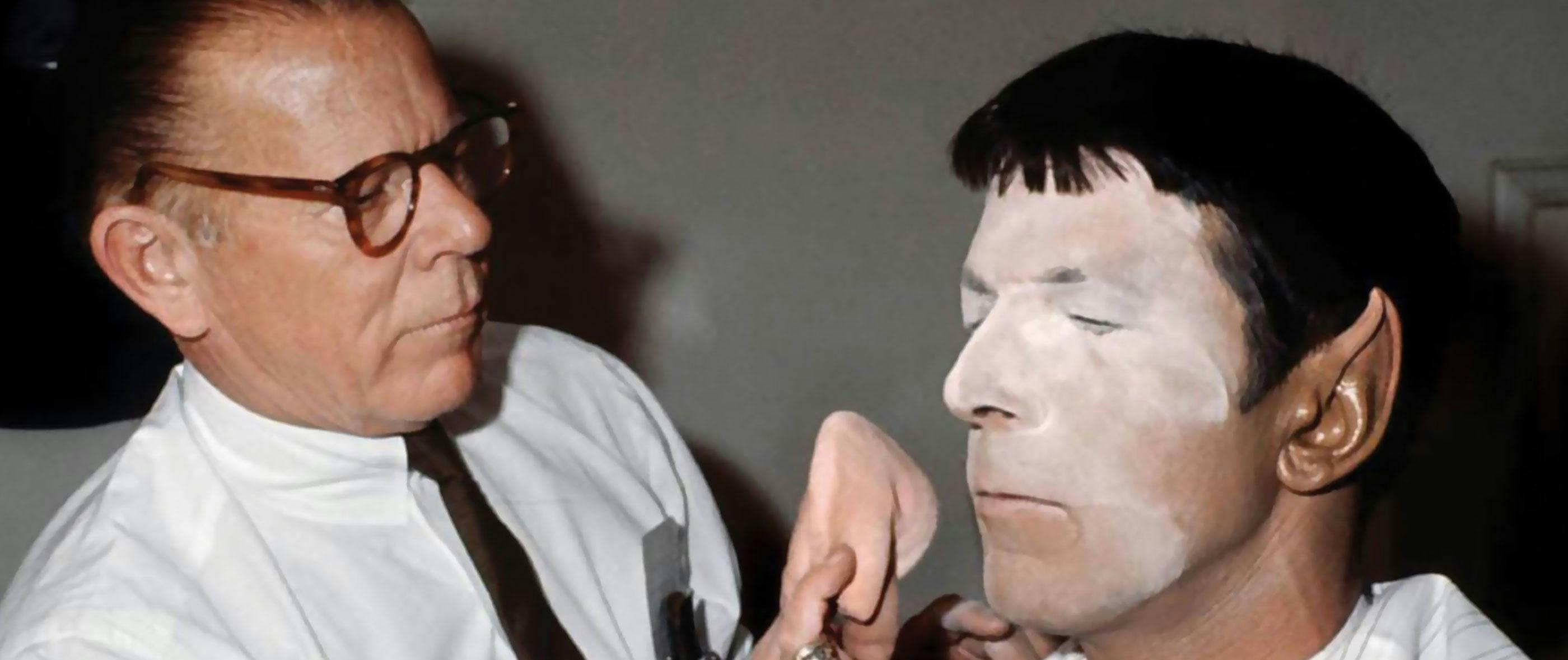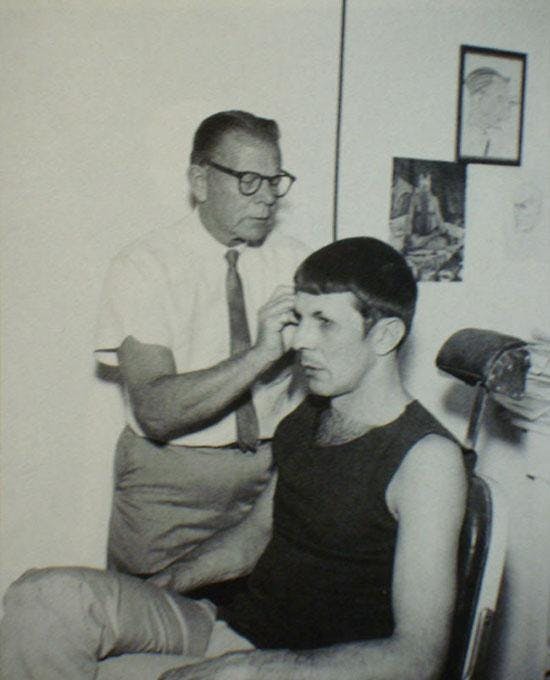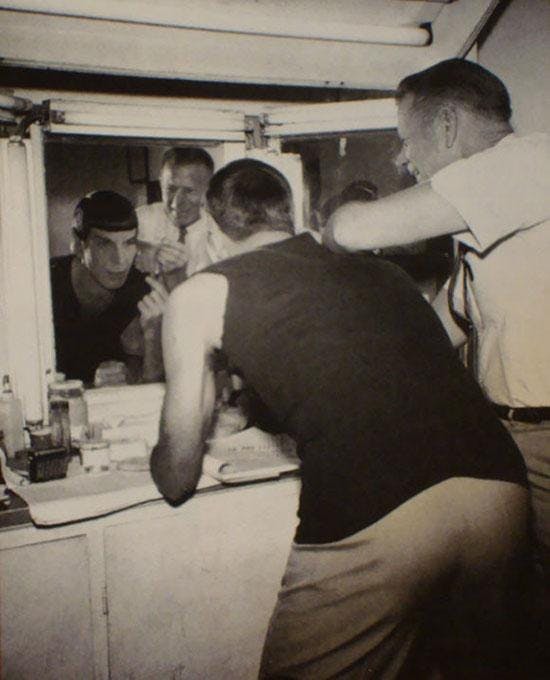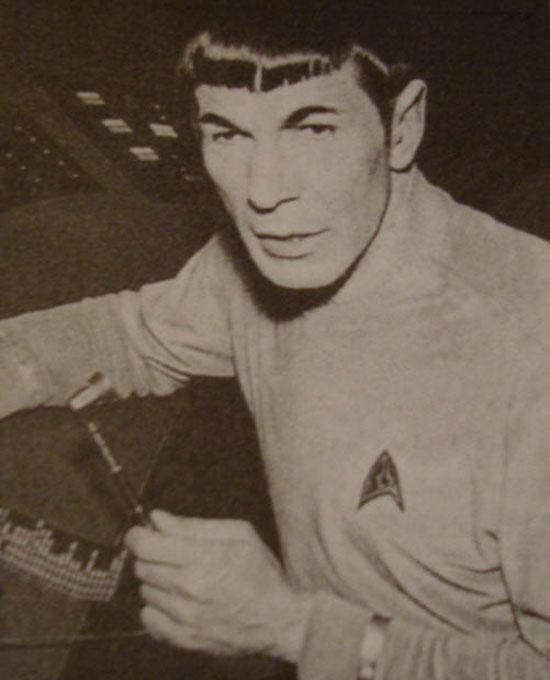Published Sep 27, 2016
Creating Star Trek's First Alien: Mr. Spock
Creating Star Trek's First Alien: Mr. Spock

Fred Phillips designed Spock’s famous pointed ears for the original pilot episode “The Cage.” Fourteen years later, during the production of Star Trek: The Motion Picture, Phillips cast his two thousandth Spock ear.
While familiar today and seemingly a simple makeup design, Gene Roddenberry recalled in The Making of Star Trek (1968) that it look a lot of tries to get it right.
"We had to try a lot of different types of ears on Leonard to get the right ones, one that looked real. We had them too big, too flat, too pointed, and so forth. So Leonard came in four or five days in a row and tried on these different kinds of ears. We would then shoot test footage and view them the next day in the projection room."

The longer it took to find the right pair of ears, the more jokes were made among the production crew about the alien makeup design. Eventually, even Leonard Nimoy began to doubt whether it was right to begin with.
"This Spock part was beginning to look to him like he’d be playing a freak with ears. He wound up by saying, 'I’ve decided I don’t want the part.'"
"Well, after all that we had gone through, and with only a few days left before shooting, and I’m certain Spock can be a meaningful and challenging role, now comes the problem of talking Leonard out of this. We must have argued for at least half an hour. I was desperately trying to convince Leonard that there is dignity in Spock and for the actor portraying him. But there had been too many comments and remarks about the pointed ears. Nimoy was unconvinced."
"Finally the only thing I could think of to say to him was, 'Leonard, look, believe me. I make this pledge to you. If by the thirteenth show you still don’t like the ears, I will personally write a script in which you will get an ear job and go back to normal.' He looked at me for a minute and then practically fell down on the floor laughing. Suddenly the ears had been put back in proper perspective. And that was the end of that problem."

Which still left the problem of applying the proper makeup. Associate producer Bob Justman recalled the complicated process in Herbert and Yvonne Fern Solow’s Star Trek Sketchbook (1997).
"The theory was that, once the molds were made, duplicate ears could be cranked out when needed and glued onto Leonard’s ears. Easier said than done. Once a pair of them had been painstakingly attached and colored to match the rest of Spock’s yellowish complexion, that was it for that pair. And when they were removed (a painful and time consuming process for Leonard, since they were attached with spirit glue and could be removed only with the use of strong solvent), they couldn’t be saved for use the next time. New day, new ears. And the rubber being used wasn’t dependable. The makeup lab had to cast pair after pair of ears until a good set was made. Later, when the series was filmed, Charles Schramm of the MGM makeup department would use an improved latex formula and crank out ears on an assembly-line basis."
It still took an hour and a half every day before filming to apply the ears. Justman recalled in The Making of Star Trek how he played a little joke on Nimoy about the problem.

"Before we started the second season, I put Leonard on, telling him I could solve the ear problem for the whole second season. I said, 'Leonard, I think I’ve come up with the answer to the ear problem. You’re going to be able to save all that time in makeup. No more being uncomfortable, no more pain, no more problems. You can just get regular makeup and everything will be perfect.' And he says, 'Yeah, what is it Bob?' And I said, 'We’re going to send you to a plastic surgeon and we’re going to point your ears. When the series is finished, we’ll pay to have them put back to normal!' I almost had Leonard convinced that it would be much easier, much less painful. The more I talked, the more he began to listen and sort of nod his head. You could almost hear the thought going through his mind, 'You know… it would possibly be much better…' At that point I couldn’t keep a straight face any longer and broke up. That’s when Leonard realized that I was putting him on and he cracked up, too."
The second stage was the creation of Spock’s characteristic Vulcan eyebrows. This required Phillips to shave the outside halves of Nimoy’s actual eyebrows during each makeup session. Phillips filled in the shape of the new eyebrows with an eyebrow pencil, then painted over those lines with spirit gum. The spirit gum was used to attach short lengths of yak belly hair, which Phillips cut from long stands, blending the small tufts into what remained of Nimoy’s own eyebrows. The final stage of the process involved applying base makeup and adding shading to ensure that shadow contours would be seen even under the bright lights of the shooting stage.
As the series began production, the use of Spock’s pointed ears was cause of great controversy between the Star Trek production team and the television network. “In 1965, the NBC Sales Department was concerned,” recalled Herb Solow, Desilu executive in charge of Star Trek at the time. “It was as if they believed that, after Satan had been cast out the the Garden of Eden, he was reincarnated as actor Leonard Nimoy and cast into Star Trek as science officer Spock, a pointed eared, arched eyebrowed ‘satanic’ Vulcan alien.” NBC feared its advertisers and local stations would be targets of a religious backlash protesting this “devil incarnate.”
“It took several weeks for us to learn the extent to which NBC Sales had gone to disguise Spock’s ‘satanic’ pointed ears,” says Solow.

NBC had sent a very attractive Star Trek sales brochure to its station affiliates and advertisers. Close scrutiny showed, however, that an artist working for the NBC Sales Department had airbrushed Spock’s pointy ears round in all the photographs.
In order to placate the network, which was strongly advocating the use of regular ears and eyebrows on the Spock character — a move that would have seriously undermined the concept that an alien was serving onboard the Enterprise — the Star Trek production team decided to “tell NBC what they wanted to hear” in agreeing to greatly reduce Spock’s visibility in the show for the first thirteen weeks while actually proceeding without limitations on the use of the Vulcan first officer.
“The first four episodes to air featured Mister Spock in varying degrees,” according to Solow. “But by the time the fifth show was ready to air, ‘Spockmania’ had erupted and NBC’s anti-Spock campaign came to a grinding halt. Desilu’s mailroom was bulging with huge sacks of fan mail, most of which was addressed to Mister Spock.”
Nick Ottens is the man behind theForgotten Trek website. The site bills itself as "the largest resource about the production and behind the scenes of Star Trek." Online since 2002, it features concept art, photographs and interviews, some of which has never been published before.. or until now. Be sure to visit the site at Forgotten Trekand keep an eye onStarTrek.com for future pieces from the site's archive.

